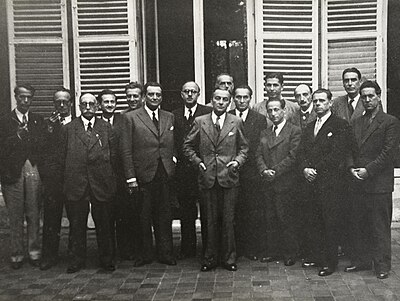National Council of the Resistance
Charles de Gaulle, exiled in London and recognized by the UK as leader of Free France, began forming a committee to unify the resistance movements.Moulin achieved the feat on 27 May 1943 with the first meeting of the Conseil National de la Résistance in the apartment of René Corbin on the second floor of 48, Rue du Four, in Paris.Representatives of the eight major resistance movements: Under Jean Moulin's earlier influence, Combat, Franc-Tireur and Libération-Sud had already agreed to regroup themselves in January 1943 to create the Mouvements Unis de la Résistance, with their joint military arms forming the Armée secrète (Secret Army).On 15 March 1944 the CNR adopted, after months of negotiations, the Programme of the Conseil National de la Résistance.Some of the proposed measures were applied, at least to a certain extent, after liberation, including the nationalisation of energy (Électricité de France was founded in 1946), insurance companies (AGF in 1945) and banks (Crédit Lyonnais in 1945, Société Générale in 1946), the creation of social security programs and the independence of trade unions.




Liberation of ParisPierre VillonGaston TessierLibération-SudJoseph LanielGeorges BidaultLibération-NordDaniel MayerJean-Pierre LévyFranc-TireurPaul BastidLouis SaillantFrenchFrench ResistanceWorld War IIVichy regimeCharles de Gaulleresistance movementsGerman occupationFrancs-Tireurs et PartisansCommunist Party of FrancemaquisFree FranceJean MoulinFront NationalCeux de la LibérationCeux de la RésistanceCharles LaurentOrganisation Civile et MilitaireClaude BourdetCombatEugène Claudius-PetitMouvements Unis de la RésistanceArmée secrèteLabour Charter of the 4th of OctoberConfédération générale du travailConfédération Française des Travailleurs ChrétiensFrench Third RepublicFrench Communist PartyAndré Le TroquerFrench Section of the Workers' InternationalMarc RucartRadical-SocialistsParti démocrate populairel'Alliance DémocratiqueFédération républicaineCaluireKlaus BarbieAlexandre Parodisocial democracyplanned economyliberationnationalisationÉlectricité de FranceCrédit LyonnaisSociété Généralesocial securityacquis sociauxWikisourceAlbaniaAustriaBelgiumBulgariaDenmarkNetherlandsEstoniaGermanyGreeceLatviaLithuaniaLuxembourgMacedoniaNorwayPolandRomaniaSlovakiaYugoslaviaCreationand controlCharles de Gaulle during World War IIAppeal of 18 JuneDepartmental Committee of LiberationEmpire Defense CouncilFrench National CommitteeFrench Committee of National LiberationProvisional Consultative AssemblyFree French ForcesAir ForceArmy of AfricaFrench Liberation ArmyKoufraBir HakeimGazala1st Free French DivisionCompanions of LiberationRadio LondresFree French AfricaDomesticoperationsMovementsFTP–Foreign Labour ForceFrench Forces of the InteriorMouvements unisMusée de l'HommeNational FrontNetworksAllianceOrganisation de résistance de l'arméeBrutusComet LineCdL CinémaMithridateMorhangeConfrérie Notre-DameJade-AmicolJade-FitzroyVercorsHousewives' demonstrationsUnion des femmes françaisesUndergroundmediaDéfense de la FranceLes Éditions de MinuitL'HumanitéLes Lettres FrançaisesLibération (sud)Témoignage chrétienLa Voix du NordFreeFrenchAfrica